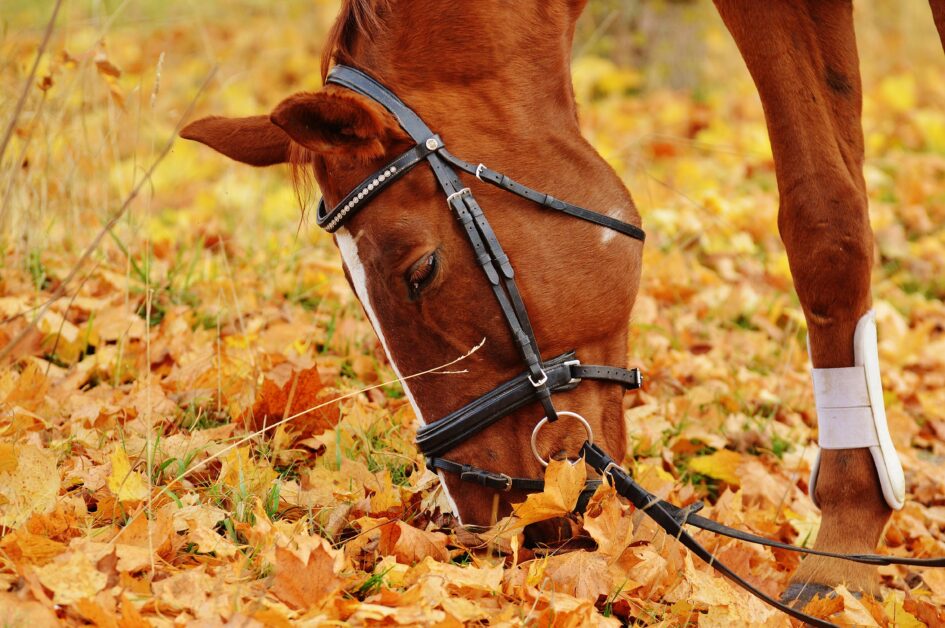Fluffy jackets, toasty fires, and football season – What’s not to love about the Fall? As we usher in the autumn weather and leaves begin to blanket the ground, it’s important that horse owners know the potential threat of poisonous Fall leaves. Some trees, shrubs, and plants that are shedding their leaves can be toxic to your horse if ingested. Below we will break down all of the foliage you should be on the lookout for and how to help keep your horse safe all season long.
Common Toxic Trees and Plants
- Red Maple – Most commonly found in the Eastern USA, the wilted leaves of the Red Maple can cause symptoms such as lethargy, jaundice, colic, and in rare and extreme cases death.
- Black Walnut – A native tree to the Eastern and Central USA, the Black Walnut is toxic if ingested, and even if your horse simply comes in contact with shavings or bedding made from Black Walnut wood. Consumption can lead to laminates and other health concerns.
- Oak Tree – Oak leaves, particularly those of the black and red varieties contain tannins that can be harmful to your horse if consumed in large amounts. These symptoms may include colic, diarrhea, and kidney damage.
- Yew Shrubs – These shrubs and trees are found in Eastern and Central USA. They have toxic alkaloids that can be deadly to horses. Ingesting these can result in sudden death without warning signs.
- Bracken Fern – Found across the USA, the Bracken Fern can be toxic if consumed. Symptoms include depression, staggering, and in very severe cases, paralysis.
Identifying Poisonous Leaves
Consult The Experts:
Identifying plants on your property isn’t something we are all naturally good at. If you’re unsure of which Fall leaves might be harmful, you should consult with a local horticultural expert, veterinarian, or even one of those handy apps that can identify plants.
Educate Yourself About Toxic Plants:
Each region has different native plants that you should make sure you familiarize yourself with. While the list above is a good reference, it’s always best to look at your specific area to make sure you have a complete list of all of the Fall leaves that could be dangerous.
Inspect Your Property:
As easily as the wind blows, seeds spread so it’s always best to keep an eye on your property regularly to make sure no new trees or shrubs have taken root near where your horses graze.
4 Ways to Protect Your Horse
Pasture Management:
Maintaining your pastures and paddocks is the most important and easy way to protect your horse from potentially toxic trees and shrubs. Regularly checking these areas and checking for fallen leaves and branches will ensure your horse has a safe place to graze all Fall.
Supplemental Feedings:
We talk a lot about supplements on our blog, but making sure that your horse has high-quality forage and feed will help discourage your horse from grazing on potentially toxic plants and leaves.
Leaf Raking:
If you have areas with a lot of tree coverage, you should consider raking leaves regularly to keep your horse’s grazing area clear. This will reduce the risk of ingesting any potentially toxic leaves.
Seek Veterinarian Attention:
Better safe than sorry – If you suspect your horse has ingested toxic leaves contact your vet immediately. The sooner your vet has a chance to check your horse, if toxic leaves have been ingested the less likely your horse is to experience any long-term side effects.
The Texas Horseman Magazine compiled the facts of this blog. If you’d like to learn more you can visit their site at www.theTexasHorseman.com.
Learn More
The changing climate has everyone’s immune systems working overtime. This is one of the things that has the largest impact on your horse’s hoof health. The constant wet then dry opens the door for infection or structural issues in the hoof. Learn more about the things to look out for this Fall HERE!
Shop Now
You can shop all our products at FarmVet.com 24/7. You can also call one of our friendly Sales Associates at 1-888-837-3626 or email your order to info@farmvet.com.


Leave a Reply